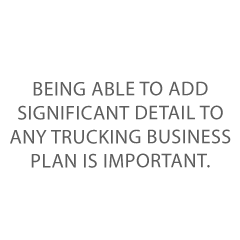If you’re a truck driver looking to create your own business, then you are going to need a trucking business plan. This is not just for showing or to please a lender or business credit provider. It is also a vital document to help you run a successful trucking company.
If it feels daunting, don’t worry. There are plenty of sample business plans out there. No one needs to know if you used a trucking business plan template.
10 Steps To Create A Trucking Business Plan
Any successful trucking industry business plan will inevitably have many of the same elements as those found in business plans for other industries in North America and elsewhere.
And keep in mind that the SBA has an applicable business plan template for a load of business ideas. One is bound to work or at least be adaptable to your needs.
Step 1 – Consider Your Audience
Your audience for your business plan is not your target market or any potential customer. Rather, the people who are going to be reading your business plan will be potential lenders and/or investors.
Any possible investor wants to know if you have done your research. But first, even before that, who are you writing to? Knowing who you are writing to, and tailoring your message accordingly, will save you time and money down the line
Therefore, start with envisioning your reader. Take the time to consider what their questions are going to be. Make answering their questions a priority as you start to write. This will not only keep you on track. It will also help you out in case you get writer’s block.
Because your trucking company business plan is for investors and lenders, and not customers, now is not the time to be salesy. Rather, now is the time to lay out the particulars of your small business’s finances.
This is both the finances you have here and now and any future financial projection you can demonstrate and prove. Saying you’re going to make a million dollars in three years is one thing. Showing specifically how you will do so is another matter entirely.
And, of course, the latter is what you are going to need to put on your business plan.
Step 2 – Write an Executive Summary
An executive summary serves as a complete summary of your business idea. The description goes into further detail than the summary. Your executive summary adds a company description, answering such questions as:
What type of business is it? What product or service will it offer? Even if you feel these are questions with obvious answers, answer them anyway.
This is part of the trucking company business plan where you work to get others excited about your business. Catch their attention and make them want to keep reading.
Here is where you are going to write a description of the trucking services you are looking to provide. Is your business long-haul with a large fleet? Or do you have one dump truck and are going to work locally only?
What sort of freight will you be hauling? Take into account the added expenses of hauling perishable goods or hazardous materials. The initial operating cost for both is higher than for other types of trucking.
How will you maintain cash flow if it takes a while for your customers to pay you?
Go beyond what may be your background from driving. Now, you put on your owner-operator trucker’s cap. Use your executive summary to make it clear how your business will fit in with the overall trucking industry.
Step 3 – Add a Strategies Section
The strategies section lays out your plan for getting started. Do you have a marketing plan? Where will your business be located (even a virtual office matters here)? How many employees will you start with? What is your ramp-up plan?
Your truck business will have to have some sort of strategy.
Outline how you will plan for attracting freight shippers and others to work with you. Add how you work to cover cash flow if times get lean. How can you maintain your balance sheet in the face of uneven cash flow?
Also, will you be apportioning your plates and using an international registration plan? This type of registration recognizes that vehicles are registered in different jurisdictions than they may operate.
And you’ll have to have it if your gross vehicle weight (and load) exceeds 26,000 pounds, or it has more than two axles (regardless of weight), and/or it operates interstate or in more than one province.
It then allows a portion of the payment of the licensing fees to be apportioned to the states or provinces where they travel. If your trucking company is going to travel in more than one of the states in the United States, then you will need this plan.
Step 4 – Perform Research
This research is also referred to as market analysis.
Understand your particular niche. How do you intend to fill it? Your trucking business plan will not be impressive to investors or lenders if you do not show you have performed research.
Marketing analysis will take some time and, yes, it will most likely take some money. As a result, you should consider it an investment in your trucking business.
 Being able to add significant detail to any trucking business plan is important. But being able to back up the details and provide insights? That will take any trucking business plan to the next level.
Being able to add significant detail to any trucking business plan is important. But being able to back up the details and provide insights? That will take any trucking business plan to the next level.
And don’t consider this market analysis research as simply being a means of impressing lenders or investors. Also, consider it as a vital part of keeping your trucking business plan relevant for years to come.
In a few years, or maybe even sooner, you will be glad you spent the money and the time to get this research done. Industry analysis will be vital!
Your trucking business plan is, after all, meant to be a road map for your business. If you think you are going to simply stick it in a drawer once you get business financing, then you are going about this all wrong.
Step 5 – Add Your Analysis of Audience
The analysis of the audience will have to answer the following questions:
- What need will your trucking business fill, and for whom? For example, are you a trucking company handling local deliveries for an out-of-the-way location? Are you transporting hazardous materials across state lines?
- How will your business fill these needs?
As a small business owner, you’re not throwing spaghetti against the wall. Instead, you are making a detailed and well-reasoned trucking business plan. After all, you may end up having employees depending on your business’s succeeding.
The step from truck driver to business owner adds a lot of responsibility. Your business ideas will inform how you get started. But understanding what your audience is like, and their needs, will keep your small business going.
This, once again, goes back to keeping your business plan as a living document. Keep it as a reference for your trucking company.
Imagine if—heaven forbid—you were suddenly incapable of running your business. A good trucking company plan will make it possible for your employees and your successor(s) to run the company smoothly and in accordance with your vision.
This will help even if yours is a sole proprietorship.
This also means that it is entirely possible for your analysis of the audience to change over time. This is perfectly normal.
Step 6 – Include a Competitive Analysis
The competitive analysis is exactly what it says. That is, it analyzes the competition. It answers the following questions.
- Is there already a trucking business that is currently working to fill this need?
- Is there room in the niche for more than one such business?
- How do you plan to compete with all of the preexisting trucking companies already competing in this space?
- What is going to be so different about your trucking business that it will convince your competitors’ clients to switch?
- How will you anticipate and solve some of the problems you see other trucking businesses facing?
- Do you have an operations plan that can help you cut some of your competition’s operating costs?
In short, is there a place in this corner of the trucking industry for your business to shine and become a successful trucking business? Will you be able to meet your business goals? Do you have a marketing strategy?
This will also go directly to your pricing strategy, whether yours is a limited liability company, or you’re a sole proprietor, or something else. Analyzing how the competition is doing will help with your own market analysis.
Step 7 – Include Your Plan for Design and Development
Note: this is not where you lay out an artistic vision. Rather, the plan for design and development explains how the process will play out, from start to finish. What are the steps that you are going to take? In essence, this is a more detailed version of your strategies section.
Here is where you add details. Will your trucking company be run by just you, or someone else? Will you become a member of the American Trucking Association?
How and when will you get your trucking authority from the government so your trucking business can haul freight? If you experience delays in getting your operating authority, it will harm your trucking business.
When your trucking business is low on funds, will you turn to freight factoring companies, so you can get enough cash to cover your trucking expenses, even if your customers are late paying you? If not, then how else will you cover any potential cash shortfalls?
Like many other portions of your business plan, this may very well be a section that changes over time.
Specificity and flexibility should not be mutually exclusive.
Step 8 – Add Your Plan for Operation Management
The plan for operation management talks about who will own the business, and who will run it from day to day. This could be as simple as stating that you are going to be the sole owner and operator.
Or, it could be as complex as laying out a complete partnership plan or board of directors format. Do you have the management skills and plan to run the business directly or hire a manager for the day-to-day operations? The place to discuss that is here.
This is where a lot of new business owners can get lost. How do you have financials if there is no business yet? You will have to lay out your funding plan in this section. So, the questions you are answering are:
- How much money do you already have?
- Where did you get your current funds? Did they come from angel investors, personal savings, borrowing from your 401(k), or something else altogether?
How much do you need? How will you use the funds? This section will also contain a complete set of financial projections. These projections often go out for at least 5 years. It’s best, if possible, to have an accountant put together your projections.
It’s a lot easier than trying to do all the business mathematics yourself.
Step 9 – Add an Appendix (Optional)
An appendix is an optional part of any trucking business plan. But it is recommended by most professionals, including The Small Business Administration. It can include such things as owner credit histories, resumes, product pictures, and even letters of reference.
If applicable, licenses, permits, patents, legal documents, and other contracts should be included as well.
Anything you can include that makes it easier for an investor or a lender is going to be a good move. You have the space, so why not use it? More detail about your trucking company is just about always going to be better than less detail.
So, why not outline the expenses covered in your trucking company’s financial plan? Adding these sorts of details to your trucking company business plan will help potential investors and lenders see if there are any upcoming events that will impact your business negatively.
What sorts of events? Those could be anything from another pandemic lockdown to a bad harvest or a strike to an increase in oil prices.
The more variables your trucking company takes into consideration, the better your trucking business plan is going to be.
Go beyond the standard trucking company business plan template here, and dig into the nuances of the industry.
Step 10 – Have Your Plan Designed so it Becomes a Professional Presentation
Your presentation is important as well. Your business plan should be professional in both its appearance and its content.
If you are using your plan to apply for a loan, do not just fill out the questions on a loan application. Take the time to put together a well-written and well-designed strategy.
This is where a good business plan writer can come in handy. It is possible to do it yourself but be sure to use all available resources like the Small Business Administration and Small Business Development centers.
You need this document for more than just to get business financing. It can help you make decisions about growth. It can also help you recognize and shore up weaknesses. This document also highlights your strengths for potential lenders, investors, and partners.
And that can even help you convince partners to join your business. A well-researched business plan can help you recognize opportunities, as well, even some you may not have considered previously.
Maybe there is a market need you can fill that you didn’t even see until you did the market research for this document.
But investors, lenders, potential partners, and others will not know any of this if they cannot understand your business from its plan or if the plan is too disorganized and difficult to read. The document very looks and feel are as important as what is in it.
Lenders look at a load of business plans all the time. Make yours stand out.
Takeaways
Your trucking business plan has a lot riding on it. Being precise but also flexible is crucial. It is a chance to show investors, business partners, and lending institutions that you have done your best to cover as many contingency situations as possible.
And, it is a blueprint for your business’s future. Much like a GPS system or an old-fashioned paper map can show you the best route (or perhaps the only route) for your truck, a trucking company business plan will show you the way.
Given that your business plan is vital for getting your business financing, give us a call to discuss your financing options and how business credit can improve your chances of getting the cash you need, when you need it.

